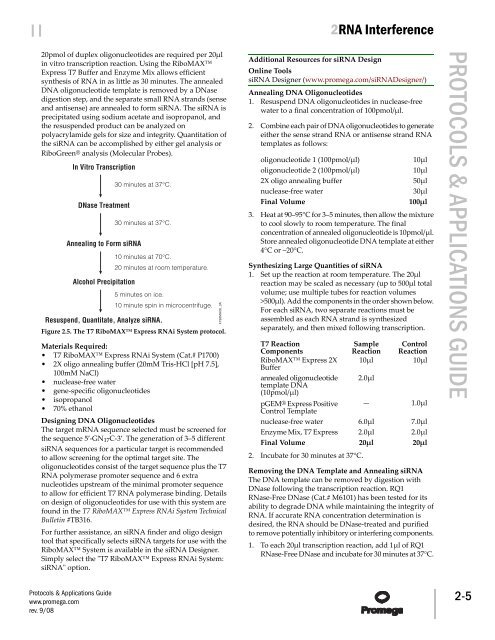Protocols and Applications Guide (US Letter Size) - Promega
Protocols and Applications Guide (US Letter Size) - Promega
Protocols and Applications Guide (US Letter Size) - Promega
Create successful ePaper yourself
Turn your PDF publications into a flip-book with our unique Google optimized e-Paper software.
|| 2RNA Interference<br />
20pmol of duplex oligonucleotides are required per 20µl<br />
in vitro transcription reaction. Using the RiboMAX<br />
Express T7 Buffer <strong>and</strong> Enzyme Mix allows efficient<br />
synthesis of RNA in as little as 30 minutes. The annealed<br />
DNA oligonucleotide template is removed by a DNase<br />
digestion step, <strong>and</strong> the separate small RNA str<strong>and</strong>s (sense<br />
<strong>and</strong> antisense) are annealed to form siRNA. The siRNA is<br />
precipitated using sodium acetate <strong>and</strong> isopropanol, <strong>and</strong><br />
the resuspended product can be analyzed on<br />
polyacrylamide gels for size <strong>and</strong> integrity. Quantitation of<br />
the siRNA can be accomplished by either gel analysis or<br />
RiboGreen® analysis (Molecular Probes).<br />
In Vitro Transcription<br />
DNase Treatment<br />
Annealing to Form siRNA<br />
Alcohol Precipitation<br />
30 minutes at 37°C.<br />
30 minutes at 37°C.<br />
10 minutes at 70°C.<br />
20 minutes at room temperature.<br />
Resuspend, Quantitate, Analyze siRNA.<br />
5 minutes on ice.<br />
10 minute spin in microcentrifuge.<br />
Figure 2.5. The T7 RiboMAX Express RNAi System protocol.<br />
Materials Required:<br />
• T7 RiboMAX Express RNAi System (Cat.# P1700)<br />
• 2X oligo annealing buffer (20mM Tris-HCl [pH 7.5],<br />
100mM NaCl)<br />
• nuclease-free water<br />
• gene-specific oligonucleotides<br />
• isopropanol<br />
• 70% ethanol<br />
Designing DNA Oligonucleotides<br />
The target mRNA sequence selected must be screened for<br />
the sequence 5′-GN17C-3′. The generation of 3–5 different<br />
siRNA sequences for a particular target is recommended<br />
to allow screening for the optimal target site. The<br />
oligonucleotides consist of the target sequence plus the T7<br />
RNA polymerase promoter sequence <strong>and</strong> 6 extra<br />
nucleotides upstream of the minimal promoter sequence<br />
to allow for efficient T7 RNA polymerase binding. Details<br />
on design of oligonucleotides for use with this system are<br />
found in the T7 RiboMAX Express RNAi System Technical<br />
Bulletin #TB316.<br />
For further assistance, an siRNA finder <strong>and</strong> oligo design<br />
tool that specifically selects siRNA targets for use with the<br />
RiboMAX System is available in the siRNA Designer.<br />
Simply select the "T7 RiboMAX Express RNAi System:<br />
siRNA" option.<br />
<strong>Protocols</strong> & <strong>Applications</strong> <strong>Guide</strong><br />
www.promega.com<br />
rev. 9/08<br />
4196MA06_3A<br />
Additional Resources for siRNA Design<br />
Online Tools<br />
siRNA Designer (www.promega.com/siRNADesigner/)<br />
Annealing DNA Oligonucleotides<br />
1. Resuspend DNA oligonucleotides in nuclease-free<br />
water to a final concentration of 100pmol/µl.<br />
2. Combine each pair of DNA oligonucleotides to generate<br />
either the sense str<strong>and</strong> RNA or antisense str<strong>and</strong> RNA<br />
templates as follows:<br />
oligonucleotide 1 (100pmol/µl)<br />
oligonucleotide 2 (100pmol/µl)<br />
2X oligo annealing buffer<br />
nuclease-free water<br />
Final Volume<br />
10µl<br />
10µl<br />
50µl<br />
30µl<br />
100µl<br />
3. Heat at 90–95°C for 3–5 minutes, then allow the mixture<br />
to cool slowly to room temperature. The final<br />
concentration of annealed oligonucleotide is 10pmol/µl.<br />
Store annealed oligonucleotide DNA template at either<br />
4°C or –20°C.<br />
Synthesizing Large Quantities of siRNA<br />
1. Set up the reaction at room temperature. The 20µl<br />
reaction may be scaled as necessary (up to 500µl total<br />
volume; use multiple tubes for reaction volumes<br />
>500µl). Add the components in the order shown below.<br />
For each siRNA, two separate reactions must be<br />
assembled as each RNA str<strong>and</strong> is synthesized<br />
separately, <strong>and</strong> then mixed following transcription.<br />
T7 Reaction<br />
Components<br />
RiboMAX Express 2X<br />
Buffer<br />
annealed oligonucleotide<br />
template DNA<br />
(10pmol/µl)<br />
pGEM® Express Positive<br />
Control Template<br />
nuclease-free water<br />
Enzyme Mix, T7 Express<br />
Final Volume<br />
2. Incubate for 30 minutes at 37°C.<br />
Sample<br />
Reaction<br />
10µl<br />
2.0µl<br />
—<br />
6.0µl<br />
2.0µl<br />
20µl<br />
Control<br />
Reaction<br />
10µl<br />
1.0µl<br />
7.0µl<br />
2.0µl<br />
20µl<br />
Removing the DNA Template <strong>and</strong> Annealing siRNA<br />
The DNA template can be removed by digestion with<br />
DNase following the transcription reaction. RQ1<br />
RNase-Free DNase (Cat.# M6101) has been tested for its<br />
ability to degrade DNA while maintaining the integrity of<br />
RNA. If accurate RNA concentration determination is<br />
desired, the RNA should be DNase-treated <strong>and</strong> purified<br />
to remove potentially inhibitory or interfering components.<br />
1. To each 20µl transcription reaction, add 1µl of RQ1<br />
RNase-Free DNase <strong>and</strong> incubate for 30 minutes at 37°C.<br />
PROTOCOLS & APPLICATIONS GUIDE 2-5
















